
Quainton Road railway station was opened in 1868 in under-developed countryside near Quainton, in the English county of Buckinghamshire, 44 miles (71 km) from London. Built by the Aylesbury and Buckingham Railway, it was the result of pressure from the 3rd Duke of Buckingham to route the railway near his home at Wotton House and to open a railway station at the nearest point to it. Serving a relatively underpopulated area, Quainton Road was a crude railway station, described as "extremely primitive".
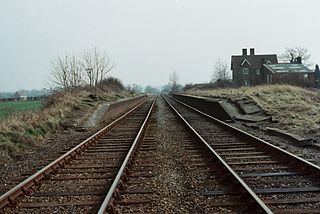
Verney Junction railway station was an isolated railway station at a four-way railway junction in Buckinghamshire, open from 1868 to 1968; a junction existed at the site without a station from 1851.

Buckinghamshire Railway Centre is a railway museum operated by the Quainton Railway Society Ltd. at Quainton Road railway station, about 5 miles (8.0 km) west of Aylesbury in Buckinghamshire, England. The site is divided into two halves which are joined by two foot-bridges, one of which provides wheelchair access. Each side has a demonstration line with various workshop buildings as well as museum buildings.
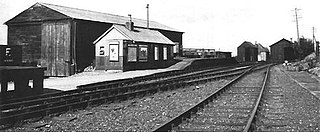
Brill railway station was the terminus of a small railway line in Buckinghamshire, England, known as the Brill Tramway. Built and owned by the 3rd Duke of Buckingham, it was later operated by London's Metropolitan Railway, and in 1933 briefly became one of the two north-western termini of the London Underground, despite being 45 miles (72 km) and over two hours' travelling time from the City of London.
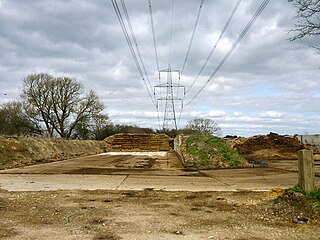
Granborough Road railway station was a station serving the village of Granborough, to the north of Quainton in Buckinghamshire, England.

Claydon railway station is a former railway station on the 'Varsity Line', that served the village of Steeple Claydon in Buckinghamshire.
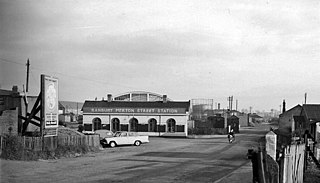
Banbury Merton Street was the first railway station to serve the Oxfordshire market town of Banbury in England. It opened in 1850 as the northern terminus of the Buckinghamshire Railway providing connections to Bletchley and Oxford and closing for passengers in 1961 and goods in 1966.
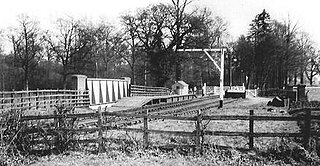
Wood Siding railway station was a halt in Bernwood Forest, Buckinghamshire, England. It opened in 1871 as a terminus of a short horse-drawn tramway built to assist the transport of goods from and around the Duke of Buckingham's extensive estates in Buckinghamshire, as well as connect the Duke's estates to the Aylesbury and Buckingham Railway at Quainton Road.
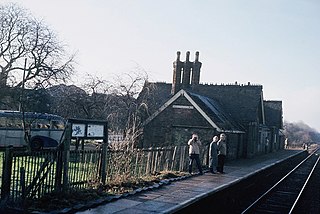
Winslow railway station refers to either one of two railway stations which historically served or is planned to serve, the town of Winslow in north Buckinghamshire, England. The original station (1850–1968) was on the former Varsity Line between Cambridge and Oxford. As of August 2023, construction of a new station nears completion and is scheduled to be served by East West Rail, as part of the plan to reinstate the Oxford–Cambridge service.
The Buckinghamshire Railway was a railway company in Buckinghamshire and Oxfordshire, England that constructed railway lines connecting Bletchley, Banbury and Oxford. Part of the route is still in use today as the Oxford to Bicester Line.

Buckingham was a railway station which served Buckingham, the former county town of Buckinghamshire, England, between 1850 and 1966.
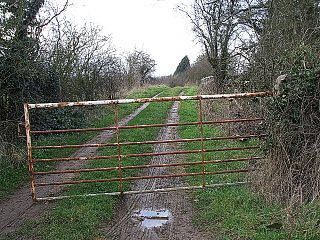
Radclive Halt was a railway station on the Banbury to Verney Junction Branch Line which served the village of Radclive in Buckinghamshire, England, from 1956 to 1961.
Water Stratford Halt was a railway station on the Banbury to Verney Junction Branch Line which served the village of Water Stratford in Buckinghamshire, England, from 1956 to 1961.

Farthinghoe was a railway station which served the Northamptonshire village of Farthinghoe in England. It opened in 1851 as part of the Buckinghamshire Railway's branch line to Verney Junction which provided connections to Bletchley and Oxford and closed in 1963.
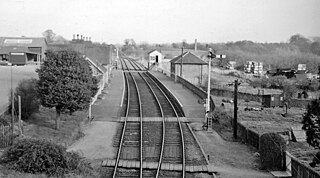
Brackley Town was a railway station which served the Northamptonshire town of Brackley in England. It opened in 1850 as part of the Buckinghamshire Railway's branch line to Verney Junction which provided connections to Banbury, Bletchley and Oxford and closed in 1963.

Padbury railway station served the village of Padbury in the English county of Buckinghamshire. It opened in 1878 as part of the Buckinghamshire Railway's branch line to Verney Junction which provided connections to Banbury, Bletchley and Oxford and closed in 1964.

Wotton railway station was a small station in Buckinghamshire, England, built by the Duke of Buckingham in 1871. Part of a private horse-drawn tramway designed to carry freight from and around his lands in Buckinghamshire, Wotton station was intended to serve the Duke's home at Wotton House and the nearby village of Wotton Underwood. In 1872 the line was extended to the nearby village of Brill, converted to passenger use, equipped with steam locomotives, and renamed the Brill Tramway. In the 1880s, it was proposed to extend the line to Oxford, but the operation of the line was instead taken over by London's Metropolitan Railway.

Westcott railway station was a small station built to serve the village of Westcott, Buckinghamshire, and nearby buildings attached to Baron Ferdinand de Rothschild's estate at Waddesdon Manor. It was built by the Duke of Buckingham in 1871 as part of a short horse-drawn tramway to allow for the transport of goods from and around his extensive estates in Buckinghamshire and to connect the Duke's estates to the Aylesbury and Buckingham Railway at Quainton Road. A lobbying campaign by residents of the town of Brill led to the tramway being converted for passenger use and extended to Brill railway station in 1872, becoming known as the Brill Tramway.

Waddesdon Road railway station, called Waddesdon railway station before 1922, was a small halt in open countryside in Buckinghamshire, England. It was opened in 1871 as part of a short horse-drawn tramway to assist with the transport of goods from and around the Duke of Buckingham's extensive estates in Buckinghamshire and to connect the Duke's estates to the Aylesbury and Buckingham Railway at Quainton Road. In 1872 the line was expanded and converted for passenger use, becoming known as the Brill Tramway. In 1899 the operation of the line was taken over by the London-based Metropolitan Railway.
The Banbury to Verney Junction branch line was a railway branch line constructed by the Buckinghamshire Railway which connected the Oxfordshire market town of Banbury with the former Oxford/Cambridge Varsity line and the former Metropolitan Railway at Verney Junction, a distance of 21 miles 39 chains. Onward routes from there ran to the West Coast Main Line at Bletchley via Brackley and Buckingham and thence to Cambridge, or to Aylesbury for London.



















